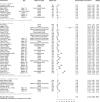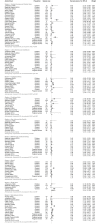The Seroprevalence of Hepatitis C Antibodies in Immigrants and Refugees from Intermediate and High Endemic Countries: A Systematic Review and Meta-Analysis
- PMID: 26558905
- PMCID: PMC4641717
- DOI: 10.1371/journal.pone.0141715
The Seroprevalence of Hepatitis C Antibodies in Immigrants and Refugees from Intermediate and High Endemic Countries: A Systematic Review and Meta-Analysis
Erratum in
-
Correction: The Seroprevalence of Hepatitis C Antibodies in Immigrants and Refugees from Intermediate and High Endemic Countries: A Systematic Review and Meta-Analysis.PLoS One. 2015 Dec 9;10(12):e0144567. doi: 10.1371/journal.pone.0144567. eCollection 2015. PLoS One. 2015. PMID: 26650678 Free PMC article.
Abstract
Background & aims: Hepatitis C virus (HCV) infection is a significant global health issue that leads to 350,000 preventable deaths annually due to associated cirrhosis and hepatocellular carcinoma (HCC). Immigrants and refugees (migrants) originating from intermediate/high HCV endemic countries are likely at increased risk for HCV infection due to HCV exposure in their countries of origin. The aim of this study was to estimate the HCV seroprevalence of the migrant population living in low HCV prevalence countries.
Methods: Four electronic databases were searched from database inception until June 17, 2014 for studies reporting the prevalence of HCV antibodies among migrants. Seroprevalence estimates were pooled with a random-effect model and were stratified by age group, region of origin and migration status and a meta-regression was modeled to explore heterogeneity.
Results: Data from 50 studies representing 38,635 migrants from all world regions were included. The overall anti-HCV prevalence (representing previous and current infections) was 1.9% (95% CI, 1.4-2.7%, I2 96.1). Older age and region of origin, particularly Sub-Saharan Africa, Asia, and Eastern Europe were the strongest predictors of HCV seroprevalence. The estimated HCV seroprevalence of migrants from these regions was >2% and is higher than that reported for most host populations.
Conclusion: Adult migrants originating from Asia, Sub-Saharan Africa and Eastern Europe are at increased risk for HCV and may benefit from targeted HCV screening.
Conflict of interest statement
Figures




References
-
- Gower E, Estes CC, Hindman S, Razavi-Shearer K, Razavi H. Global epidemiology and genotype distribution of the hepatitis C virus infection. J Hepatol. 2014;61(Suppl. 1):S45–57. - PubMed
-
- Perz JF, Armstrong GL, Farrington LA, Hutin YJ, Bell BP. The contributions of hepatitis B virus and hepatitis C virus infections to cirrhosis and primary liver cancer worldwide. J Hepatol. 2006;45(4):529–38. - PubMed
Publication types
MeSH terms
Substances
LinkOut - more resources
Full Text Sources
Other Literature Sources
Medical

